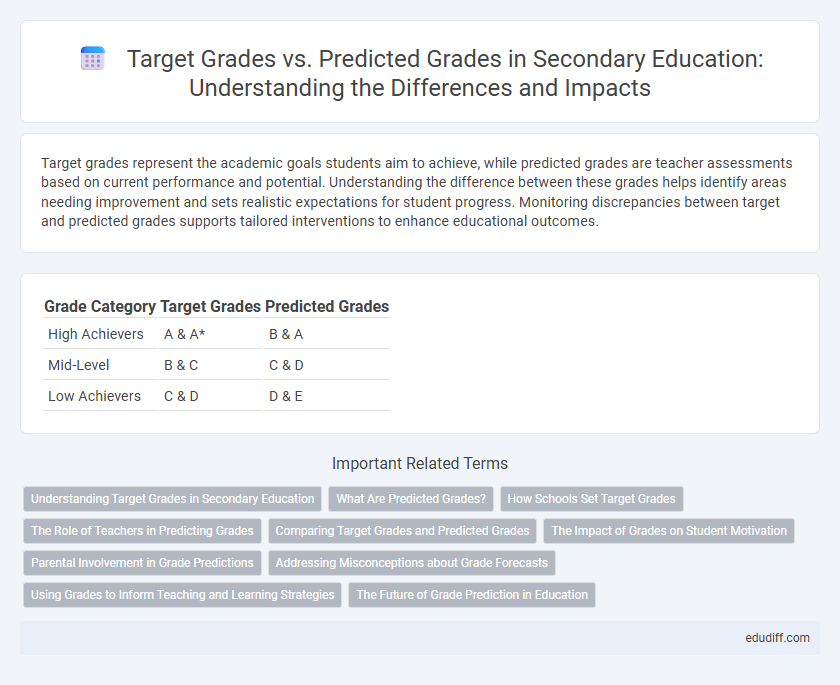Target grades represent the academic goals students aim to achieve, while predicted grades are teacher assessments based on current performance and potential. Understanding the difference between these grades helps identify areas needing improvement and sets realistic expectations for student progress. Monitoring discrepancies between target and predicted grades supports tailored interventions to enhance educational outcomes.
Table of Comparison
| Grade Category | Target Grades | Predicted Grades |
|---|---|---|
| High Achievers | A & A* | B & A |
| Mid-Level | B & C | C & D |
| Low Achievers | C & D | D & E |
Understanding Target Grades in Secondary Education
Target grades in secondary education serve as benchmarks set by schools to guide student achievement and progress throughout the academic year. These grades are derived from a combination of historical performance data, teacher assessments, and curriculum standards, providing a realistic yet challenging goal for each student. Aligning target grades with predicted grades helps educators identify learning gaps and tailor instructional strategies to support student success.
What Are Predicted Grades?
Predicted grades are teachers' estimates of the grades a student is expected to achieve in their upcoming exams, based on current performance and progress. These grades are used by secondary schools and colleges for university applications, influencing admissions decisions. Predicted grades differ from target grades, which are aspirational goals set to motivate students toward academic achievement.
How Schools Set Target Grades
Schools set target grades by analyzing past student performance data, current assessment results, and curriculum standards to establish achievable yet challenging goals. Teachers consider individual learning progress, standardized test benchmarks, and national expectations to tailor targets for each student. This process ensures that target grades motivate students while aligning with school performance objectives and accountability measures.
The Role of Teachers in Predicting Grades
Teachers play a crucial role in predicting grades by leveraging their ongoing assessments, classroom observations, and knowledge of student progress throughout the academic year. Their predictions often reflect a comprehensive understanding of individual student abilities, learning styles, and potential challenges, which standardized tests may not fully capture. Accurate grade predictions help in tailoring personalized interventions, setting realistic academic goals, and supporting student success in secondary education.
Comparing Target Grades and Predicted Grades
Target grades represent the academic goals set for students based on curriculum standards and individual capabilities, while predicted grades are assessments made by teachers estimating future performance. Comparing target grades with predicted grades helps identify discrepancies that may indicate areas requiring additional support or intervention. Analyzing these differences is crucial for adjusting teaching strategies and ensuring students remain on track to meet their educational objectives.
The Impact of Grades on Student Motivation
Target grades set clear benchmarks that enhance student motivation by providing specific goals to strive for in secondary education. Predicted grades offer realistic expectations, helping students to self-assess and adjust their effort levels accordingly. The alignment or gap between target and predicted grades crucially influences students' confidence, engagement, and overall academic drive.
Parental Involvement in Grade Predictions
Parental involvement in grade predictions significantly influences the accuracy of predicted grades compared to target grades, often leading to more realistic expectations and goal-setting. Studies show that students whose parents actively engage in discussing academic progress are more likely to align their target grades closely with predicted outcomes. This collaborative approach supports improved student motivation and tailored academic support, bridging the gap between predicted and target grades.
Addressing Misconceptions about Grade Forecasts
Target grades set aspirational benchmarks for student achievement, while predicted grades provide realistic estimations based on current performance and teacher assessments. Misconceptions often arise when target grades are mistaken for guaranteed outcomes, leading to undue pressure or complacency. Clarifying the distinct purposes of each grade type helps students and educators focus on continuous improvement and accurate progress tracking.
Using Grades to Inform Teaching and Learning Strategies
Target grades and predicted grades serve as critical benchmarks in secondary education, helping teachers tailor instructional strategies to individual student needs. Analyzing discrepancies between these grades enables educators to identify learning gaps and adjust lesson plans, ensuring more personalized and effective teaching approaches. Utilizing this data-driven method enhances student engagement and optimizes academic outcomes by aligning teaching strategies with predicted performance trajectories.
The Future of Grade Prediction in Education
Target grades and predicted grades in secondary education increasingly rely on advanced data analytics and artificial intelligence to enhance accuracy and personalize learning pathways. Machine learning algorithms analyze vast datasets, including past performance and learning behaviors, to forecast student outcomes more precisely than traditional methods. Future-grade prediction models promise to support educators in early intervention strategies, optimizing student success and educational planning.
Target Grades vs Predicted Grades Infographic

 edudiff.com
edudiff.com